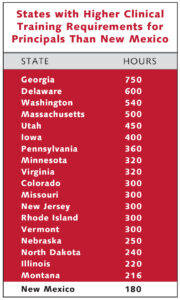Enhance Principal Pay & Training
Issue Summary News Policy Report Take Action On This Issue
2025 Legislative Update
House Bill 157 was introduced during the 2025 legislative session to improve the training and licensure of school principals. House Bill 157 was sponsored by Representatives Joy Garratt (D-Albuquerque), Raymundo Lara (D-Las Cruces), and Brian Baca (R-Los Lunas). (The bill was very similar to House Bill 22, which has been introduced during the 2024 session but did not receive a message from the governor so was not able to be considered during that year’s 30-day legislative session.)
Principal quality is the second most important factor in student success after teacher quality, because good principals are the key to recruiting and retaining good teachers. Unfortunately, New Mexico is one of the ten worst states for principal retention, with principals remaining in their jobs for less than four years on average. During 2022 and 2023, 28 percent of principals, and 41 percent of vice principals in New Mexico were new to their jobs. Two of the primary reasons for this high turnover of principals are inadequate preparation and low salaries.
In our 2022 report, Think New Mexico recommended that the state create a principal training and licensure track separate from that of other school district administrators. House Bill 157 would do just that, creating separate licensure tracks for principals and other other school administrators, with enhanced qualifications and requirements for each.
House Bill 157 passed both the House and Senate unanimously. Think New Mexico plans to work with the Public Education Department to ensure its successful implementation.
2024 Legislative Update
House Bill 22 was introduced during the 2024 legislative session to improve the pay and training of school principals. House Bill 22 was sponsored by Representatives Joy Garratt (D-Albuquerque), Raymundo Lara (D-Las Cruces), and Brian Baca (R-Los Lunas). This bill proposed to raise the standards for principal training and development through mentoring and other support. Principal quality is the second most impactful factor in student success after teacher quality.
Unfortunately, House Bill 22 did not receive a message from the governor, meaning it could not be considered during this year’s short, 30-day legislative session. We look forward to supporting these reforms in 2025.
Issue Summary
 After teacher quality, principal quality is the second most impactful factor in student success, and the two are closely connected: principals are the key to recruiting and keeping excellent teachers.
After teacher quality, principal quality is the second most impactful factor in student success, and the two are closely connected: principals are the key to recruiting and keeping excellent teachers.
New Mexico ranks second highest in the nation for teacher attrition, with nearly a quarter of teachers leaving their positions in the year studied—nine points higher than the national average. The state’s high teacher attrition is likely linked to our high rate of principal attrition. A recent report by the New Teacher Center identified New Mexico as one of the ten worst states for principal retention, with principals staying an average of well un-der four years in a position.
When researchers investigated why principals leave their jobs, among the top reasons were inadequate preparation, insufficient professional development, and low salaries.
As with teachers, when it comes to building the skills of new principals, actual practice is more effective than academic study. Yet New Mexico’s current licensure process for principals is identical to that for all other types of administrators, like school district central office staff and finance managers. As a result, the coursework is heavy on concepts like school finance and law, but it falls short in terms of training future principals in skills like organizational management, how to fairly and accurately evaluate teaching quality, best approaches to improve the skills of their teachers, and understanding the special needs of at-risk students.
 Prospective principals in New Mexico are only required to complete 180 hours of apprenticeship or internship before applying for the position—with six-hour school days, that’s only about a month of shadowing another principal before stepping into the job. Eighteen states, including some of the highest performing in the nation, have higher clinical experience requirements for principals than New Mexico, with 14 of them requiring at least 300 hours in field-based experiences.
Prospective principals in New Mexico are only required to complete 180 hours of apprenticeship or internship before applying for the position—with six-hour school days, that’s only about a month of shadowing another principal before stepping into the job. Eighteen states, including some of the highest performing in the nation, have higher clinical experience requirements for principals than New Mexico, with 14 of them requiring at least 300 hours in field-based experiences.
Think New Mexico recommends that the legislature and governor create a specialized principal licensure track that includes a semester-long paid residency with an experienced, highly effective principal.
Once a principal enters the profession, ongoing support is needed to help them keep developing their skills over time. Studies of principal coaching show that it makes a difference. For example, one study in Oakland found that principals who worked with coaches raised the academic performance index score of their schools by nearly three times the average districtwide increase.
Think New Mexico recommends that the legislature and governor expand access to professional development and coaching programs, and require that principals at all 864 public schools in the state participate in these programs.
Finally, principal salaries need to be adequate to compensate them for the time and work required to do the position well. Unfortunately, some principal salaries are actually lower than those of Level 3 teachers who hold multiple endorsements and national board certification, even though principals’ annual contracts are about 30% longer than those of teachers, averaging 250 days compared with 190 days for teachers.
Moreover, according to the most recently available data from the Public Education Department, as of 2018, principals in districts larger than 2,500 students are paid nearly $20,000 less than administrative associates in those school districts’ central offices, despite the fact that a principal has a far more profound impact on the lives of students. This salary imbalance incentivizes great teachers and principals to leave their schools and become central office administrators.
We recommend that the legislature and governor increase the minimum principal salaries to at least 30% higher than Level 3 teachers, reflecting the difference in workload—and they should also cap the salaries of central office administrators (other than the superintendent and perhaps one or two other top district staff) at no higher than the average principal in that district.
Right-sizing principal salaries and providing them with the preparation and support they need to succeed in their roles should improve principal performance and reduce principal attrition, which in turn should reduce teacher turnover and raise student achievement.
News Coverage

